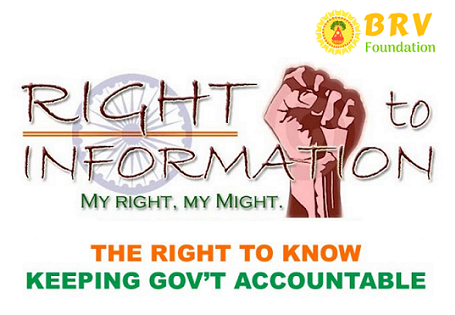Right to Information (RTI) is act of the Parliament of India to provide for setting out the practical regime of the right to information for citizens and replaces the erstwhile Freedom of information Act, 2002. Under the provisions of the Act, any citizen of India may request information from a “public authority” (a body of Government or “instrumentality of State”) which is required to reply expeditiously or within thirty days. The Act also requires every public authority to computerise their records for wide dissemination and to proactively certain categories of information so that the citizens need minimum recourse to request for information formally.
Objective of the Right to Information Act :
The basic object of the Right to Information Act is to empower the citizens,promote transparency and accountability in the working of the Government,contain corruption, and make our democracy work for the people in real sense.It goes without saying that an informed citizen is better equipped to keep necessary vigil on the instruments of governance and make the government more accountable to the governed.The Act is a big step towards making the citizens informed about the activities of the Government.
Filing an RTI to a Central Government Department and approaching the Central Information Commission
- Central Government Department Identification: The first step to file an RTI with a department of the central government would be to identify from which department the information has to be obtained. For instance, anything related to income tax should go to Income Tax department or defense related query should go to Ministry of Defense.
- Writing the Application Properly: The next step would be writing your RTI application in the prescribed format. Also, this format isn’t mandatory and you can submit your application on a plain paper as well. The language of the application can be Hindi or English. Similarly, the government can also respond in either language.
You can check the Rules for filing an RTI with Central Government Departments.
Make sure that the questions you ask relate to only one subject; the application has a chance of rejection if you ask more than one questions in a single RTI Application. For instance, if you are enquiring about your passports, then ask questions which are only related to the passports. - Make Payment of Fees: As you might know, there is some amount charged for each RTI you file. Thus, to file an application to a central government department, attach application fee of Rs. 10/- in the form of Indian Postal Order.
- Send Application: Once all the above mentioned steps are completed, send your RTI application via speed post/registered post and wait for the government’s response. If you don’t get a reply within 30 days of sending the application, you can approach the central information commission.
About the Central Information Commission:
The Central Information Commission is a government body which has been established to address the grievances of the people who have not been able to submit an RTI Application due to the following reasons:
- There is no State Public Information Officer or Central Public Information Officer appointed.
- Either of the officers (PIO) have refused to take the RTI Application.
About the Central Government Department:
In India, the government of the country is officially known as the Union Government. It is also known as the Central Government. It was established by the Constitution of India in 1950. The Central Government is the governing authority of the country’s 29 states and 7 union territories, which is collectively referred to as the Republic of India. The Central Government of India is located in New Delhi, the capital of the country.

